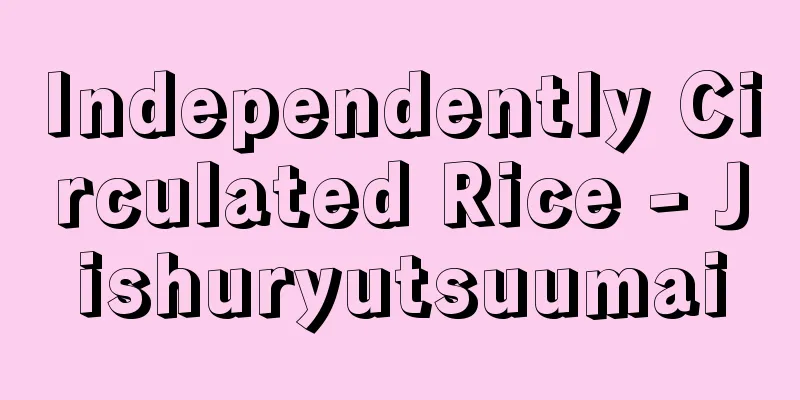Independently Circulated Rice - Jishuryutsuumai

|
This is rice that was distributed directly from farmers to wholesalers through collection agents (agricultural cooperatives) without going through the government. It was implemented in 1969 with the aim of streamlining distribution channels and reducing the deficit of the Food Control Special Account. Although it was called independent distribution, it was distributed through almost the same channels as government rice, and the difference between it and government rice was that the price was determined not by the government but by negotiations between collection agents designated by the government and wholesalers. At its peak, it accounted for 70% of the total rice distributed. The role of government rice, which ensures rice reproduction for producers and a stable supply of a certain quality and price for consumers, was still considered important at the time. The Food Agency also guided and managed price determination in the independent distribution rice market by limiting the bidding range. After that, the government placed independent distribution rice at the center of distribution, further relaxed regulations, and introduced market principles into price formation. In 1990, the Independent Distribution Rice Price Formation Organization was established and bidding transactions began. In 1995, the Food Control Act was abolished and replaced by the Law Concerning Stabilization of Supply and Demand and Prices of Staple Foodstuffs (Food Act), which established the Independently Distributed Rice Price Formation Center to ensure fair price formation in rice trading through bidding, and marked a major shift from total government control to private sector initiative. With the amendment of the Food Act in 2004, the planned distribution system was abolished and the classification of independently distributed rice was also abolished. The legal name of the center was changed to the Rice Price Formation Center. Meanwhile, with the planned distribution system gone, mandatory listing was also abolished and private transactions became the norm. With the dramatic drop in trading volume, the center was no longer able to fulfill its function as a center, and was dissolved in 2011. With distribution restrictions essentially abolished, independently distributed rice effectively disappeared. Source: Encyclopaedia Britannica Concise Encyclopedia About Encyclopaedia Britannica Concise Encyclopedia Information |
|
農家から集荷業者(農業協同組合)を通じ,政府の手を通さないで直接卸業者に流通させた米。1969年に流通経路の合理化,食糧管理特別会計の赤字の縮小などを目的として実施された。自主流通といっても政府米とほぼ同じ経路で流通し,政府米との違いは,価格決定が政府ではなく政府に指定を受けた集荷業者と卸業者の交渉によって決定される点であった。最も多い時期には全流通米の 7割をも占めた。生産者に対して米の再生産を確保し,消費者には一定品質と価格の安定した供給をはかるという政府米の役割は,当時まだ重要とされていた。食糧庁は自主流通米市場においても入札の値幅を制限するというかたちで価格決定の指導管理を行なっていた。その後,政府は自主流通米を流通の中心に位置づけ,規制をいっそう緩和し,価格形成に市場原理導入をはかるため,1990年に自主流通米価格形成機構が設立され,入札取引が始まった。1995年に食糧管理法が廃止され,代わって施行された主要食糧の需給及び価格の安定に関する法律(食糧法)に基づき,入札を通じて米取引の適正な価格形成を担保するために自主流通米価格形成センターが設けられ,国による全量管理から民間主導へと大きく変わった。2004年の食糧法改正により,計画流通制度が廃止され,自主流通米の区分も廃止された。同センターの法律上の名称は米穀価格形成センターに変わった。一方,計画流通制度がなくなったことにより義務上場も廃止され,相対取引が主流になった。取引量の激減でセンターとしての機能が果たせなくなり,2011年に同センターは解散した。流通規制が原則として廃止されたことで,自主流通米は事実上なくなった。
出典 ブリタニカ国際大百科事典 小項目事典ブリタニカ国際大百科事典 小項目事典について 情報 |
<<: Index fossil - index fossil
>>: Sisyphos (English spelling)
Recommend
Fernico
…Kovar is the trade name for an alloy of nickel, ...
Ma-yi (English spelling)
The name of the Philippines is a transliteration o...
Saigin - Saigin
? - 1709 (6th year of the Hoei period) A haiku poe...
Abd (English spelling)
Slaves under Islamic law. Strictly speaking, they ...
Lönnbohm, AEL (English spelling) LonnbohmAEL
…A master of Finnish poetry. His real name was Ar...
Irenaeus
…an important father of the so-called Old Catholi...
Tripitaka Master Cimin (English: Tripitaka Master Cimin)
680‐748 A monk from the Tang Dynasty in China, and...
Synodic period
The average period until a planet's relative ...
Behaviorism
A methodology in modern psychology that originated...
wicopy
… Willow herb is widely distributed throughout Ja...
UMB - UMB
This refers to the area reserved for loading progr...
Chemical fossil
When organic substances contained in sedimentary ...
Choir
…In the 9th century, a square or rectangular spac...
new cocoyam (English)
…Of these, taro (old cocoyam) is native to mainla...
Igara - Igara
...They are an agricultural people who cultivate ...









